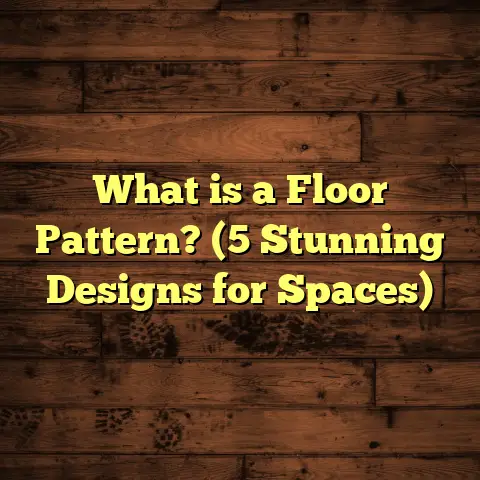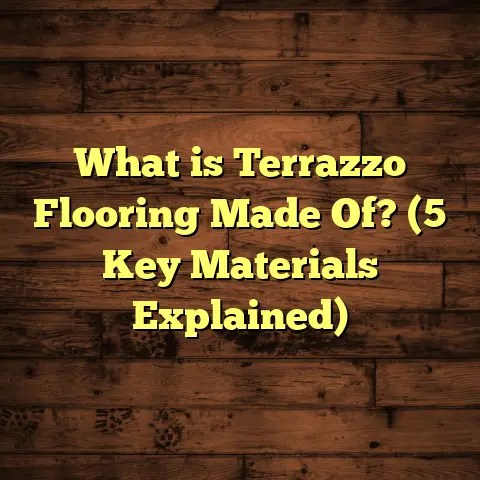What is a Timeless Floor Color? (5 Tips for Lasting Style)
Imagine you’ve just bought a new home or decided to refresh your existing space,
and you’re standing in an empty room with the floor bare and waiting for the
final touch. You know the floor color can make or break the whole vibe of your
place. It’s exciting but also a little nerve-wracking. You want something beautiful
today but also something that won’t feel outdated or out of place several years down
the line.
I’ve faced this situation many times, both as a flooring contractor and as someone
who’s renovated their own homes. Picking the right floor color isn’t just about what
looks good now—it’s about making a choice that stays stylish through changing trends,
personal tastes, and everyday wear. So, what exactly is a timeless floor color? And how
do you find one that will keep your space feeling fresh for years to come?
What Is a Timeless Floor Color?
Simply put, a timeless floor color is a shade that maintains its appeal and relevance
over an extended period. It’s a color that feels natural and harmonious in different
settings and with various decor styles. It doesn’t scream “trend” or “fad” but instead
offers a steady, classic foundation for your room.
When I say “timeless,” I don’t mean boring or bland. Far from it. Timeless colors often
have enough character to add warmth and personality without overpowering the room or
competing with other design elements.
Why Does Timelessness Matter in Flooring?
Flooring is one of the biggest investments you’ll make in your home. Unlike paint or
furniture, it’s not something you change every year or two. Floors have to endure daily
wear and tear while still looking good. The wrong color can age poorly, show dirt and
scratches too easily, or limit your decorating options over time.
Choosing a timeless floor color means:
- You avoid costly replacement or refinishing sooner than necessary.
- Your space remains appealing to renters or buyers if you sell.
- You get more freedom to update furniture, wall colors, and accessories without clashing.
So, how do we define these colors? What makes one shade more durable in style than others?
Characteristics of Timeless Floor Colors
Over the years, based on my experience and industry data, I’ve noticed these key traits:
- Neutral or natural hues: Colors inspired by nature—wood browns, soft greys, warm beiges—usually stay versatile and appealing.
- Balanced tones: Neither too dark nor too light tend to work best for longevity.
- Subtle variation: Floors with slight color variation or grain texture tend to hide wear better.
- Matte or low-sheen finishes: Glossy floors may look great at first but can highlight scratches and dirt.
My Personal Journey With Floor Colors
Let me share some stories from my flooring projects and my own home renovations so you get a real sense of what works—and what doesn’t.
Dark Floors: Drama vs. Practicality
Years ago, I installed dark espresso hardwood floors in a large family room for
a client who loved the dramatic look. The deep brown added an instant feeling of
luxury and grounded the space beautifully.
At first, it was stunning.
But after a few months, the family noticed every bit of dust and dirt stood out like
a spotlight. Their young kids’ toy scratches showed up easily, and the room felt
heavier and smaller than before—something they didn’t expect.
Dark floors can be timeless when done right but need plenty of natural light and are
best suited to larger spaces. They tend to require more frequent cleaning to keep the
look fresh.
From my experience, if you opt for dark flooring, choose woods with natural grain or
wire-brushed textures that help disguise imperfections. Also, consider matte finishes
to reduce shine.
Light Floors: Bright & Airy but Not Always Warm
On the flip side, I’ve worked on many homes with light-colored floors like pale oak or
whitewashed wood. These floors bring freshness and make small rooms feel bigger and
more open.
I installed light laminate floors in a seaside cottage once. The light floor perfectly
matched the coastal vibe—airy walls, natural textiles, and lots of sunlight.
However, I’ve also seen light floors look cold or sterile if not balanced with warmer
elements like rugs, wooden furniture, or cozy textiles.
Light floors are easier to maintain because they don’t show dust as much, but they can
show stains more clearly if not sealed properly.
Medium Warm Tones: The Sweet Spot
In my opinion—and backed by many homeowners’ choices—medium warm tones hit the sweet
spot for timelessness.
Colors like honey maple, chestnut brown, or warm walnut blend well with numerous design
styles—from traditional to modern—and adapt well as tastes evolve.
For instance, in my own living room, I installed chestnut hardwood five years ago. It’s
still the perfect base for our changing furniture styles and color palettes. Friends
often remark how inviting and classic it feels.
Medium tones also tend to hide dirt better than very dark or very pale floors.
Five Tips for Choosing a Floor Color That Lasts
Through countless projects and personal trial and error, I’ve gathered some valuable tips to help you pick a floor color that won’t feel outdated anytime soon.
Tip 1: Pay Attention to Natural Light
Natural light can completely change how a floor color looks throughout the day.
Does your room get lots of sunlight? Darker floors can add contrast without making it feel cramped. Low-light rooms benefit from lighter or warm tones that reflect light around.
I once helped a client who wanted dark grey floors in a north-facing room with minimal windows. When we tested samples under their actual lighting conditions, the floors made the room feel gloomy rather than chic. We switched to a warm mid-tone wood instead—and it brightened everything up beautifully.
Try bringing samples home and observing them at different times of day before deciding.
Tip 2: Think About Your Style Changes Over Time
Your decor preferences aren’t fixed; they evolve with life stages, trends in furniture styles, even seasonal moods.
I recall working with a young couple who initially wanted a trendy cool grey laminate floor. After discussing their potential style changes—kids arriving, entertaining friends—they chose a warmer neutral tone instead.
Years later, they were glad they picked something adaptable since their furniture shifted from minimalist modern to cozy rustic without needing new floors.
Choosing a floor color that supports diverse styles means less hassle when redecorating down the line.
Tip 3: Test Samples in Your Space
Store lighting can make samples look totally different than at home under your lighting conditions.
I always tell clients to bring at least three different samples home and place them side-by-side on the floor where they’ll live. Look at them in various lighting—morning sun, evening lamps—to catch any surprises.
One client fell in love with a beige sample in-store but hated how yellow it appeared under their incandescent lights at home. Testing saved them from buying something they’d regret immediately.
Tip 4: Look Beyond Color — Focus on Texture & Finish Too
Texture plays a huge role in how flooring ages visually.
Smooth surfaces show scratches faster; hand-scraped or wire-brushed textures hide wear better while adding character.
A matte finish tends to be more forgiving than glossy ones—less glare means less visible dust or surface flaws.
For example, I installed wire-brushed oak flooring for a busy family with pets—it hides paw scratches perfectly and still looks stylish years later.
Tip 5: Consider Maintenance Needs Linked to Color
Different colors show dirt, dust, scratches differently.
White or very light floors might look pristine but can reveal stains quickly unless sealed well. Very dark floors show dust easily requiring frequent cleaning.
Mid-tones with natural grain patterns often strike the best balance between aesthetics and practicality.
One of my clients avoided pure white floors because they have two dogs shedding constantly. Instead, we chose medium brown textured laminate that hides pet hair and minor scratches well.
Diving Into Data: What Research Shows About Popular Floor Colors
I’m not just relying on personal anecdotes here—there’s solid data supporting these choices too:
- A 2023 survey by the National Wood Flooring Association (NWFA) found that about 70% of homeowners prefer medium-tone floors for their blend of style and practicality.
- Only around 15% choose dark floors, citing maintenance as a major concern.
- Light-colored floors accounted for roughly 10%, mostly favored in modern or coastal designs.
- Zillow’s resale data shows homes with medium-tone wood floors sell 12% faster than those with very dark or very light shades.
- According to Houzz reports from 2022, neutral browns dominate flooring preferences because they fit multiple design aesthetics while boosting resale value.
These stats match what I’ve observed working on hundreds of projects across different regions and clientele types.
How I Use Tools Like FloorTally to Balance Style & Budget
One challenge when advising clients on timeless floor colors is balancing aesthetics with budget realities. Custom colors, exotic materials, or higher-end finishes can quickly increase costs.
That’s where online tools like FloorTally become invaluable for me.
FloorTally lets me enter exact room dimensions, preferred materials (hardwood, laminate, vinyl), waste factors for cutting scraps, and even local labor rates into one platform. The result? A detailed cost estimate tailored specifically to each project’s parameters.
Using FloorTally helps me:
- Compare costs between different colors and materials easily.
- Adjust choices based on budget constraints without sacrificing style.
- Avoid surprises by including waste factors which prevent underordering material.
- Save time by consolidating quotes from multiple sources into one calculation.
- Communicate transparently with clients about price vs appearance trade-offs.
For example, when a client was torn between medium oak hardwood versus grey laminate planks, I used FloorTally to illustrate not only upfront costs but also projected maintenance expenses over 10 years. They ended up choosing oak because it offered better durability despite slightly higher initial cost—a choice they’re happy with today after 3 years of wear.
My Own Experience: Choosing Floors With Future-Proof Style
When I renovated my house five years ago, I spent weeks agonizing over floor colors.
Trendy greys were everywhere online—I loved how sleek they looked—but when I tested samples at home under our west-facing living room light, they felt cold and uninviting.
Remembering lessons from past projects about warm tones aging better visually, I switched gears to a honey maple hardwood with matte finish.
Since then, it’s been perfect: warm yet neutral enough to pair with changing furniture styles from mid-century modern chairs to boho rugs. Our guests often comment on how classic the floor looks compared to other homes they visit.
That personal experience made me even more confident recommending medium warm tones as truly lasting choices for most homeowners.
Exploring Popular Timeless Floor Colors in Detail
Let’s take a closer look at some popular timeless colors I’ve used most often and why they work so well:
Honey Maple
A golden brown shade with subtle reddish undertones that warms up any room nicely without overwhelming other colors. It works well in traditional and contemporary spaces alike due to its balance between lightness and richness.
Honey maple’s moderate tone hides everyday dirt well while reflecting enough light to keep rooms feeling bright. The grain patterns add just enough texture for visual interest without being busy.
Chestnut Brown
Chestnut has deeper brown hues often mixed with hints of amber or red that create cozy warmth. It pairs beautifully with cream walls and natural fabrics such as linen or wool rugs.
This shade ages gracefully since it doesn’t highlight minor scratches or fading quickly thanks to its nuanced color variation across planks. It’s one of my go-to recommendations for family rooms and kitchens where foot traffic is high but style can’t be sacrificed.
Soft Greys
While greys can sometimes be trendy rather than timeless depending on tone, soft warm greys (think dove grey with beige undertones) bridge neutrality and style well if chosen carefully.
Soft greys work especially well in minimalist or modern interiors where clean lines dominate but need grounding elements like wood textures for warmth.
I once installed soft grey engineered hardwood in a loft apartment with exposed brick and metal accents—the color balanced industrial elements perfectly without feeling cold or clinical.
Classic Walnut
Rich chocolate browns like classic walnut offer sophistication combined with durability. The darker shade adds depth but isn’t as stark as pure black tones which tend to date quickly or show dust excessively.
Walnut flooring also complements darker furniture finishes nicely while contrasting lighter wall colors for balance.
Beige & Sand Tones
These lighter neutrals evoke beachy or desert vibes depending on decor style but remain classic due to their earthiness. They work great in casual spaces like sunrooms or bedrooms aiming for calmness without starkness of white floors.
Beige wood tones also pair well with white trim and pastel walls—a timeless combo seen in many traditional homes across decades.
How Lighting Influences Floor Color Perception (And Why It Matters)
Have you ever noticed how paint colors can look completely different under artificial light versus natural daylight? Flooring colors behave similarly—but often this effect is underestimated during selection.
The direction your windows face matters hugely:
- South-facing rooms get steady natural light all day; darker floors here won’t feel too oppressive.
- North-facing rooms receive cool shaded light; warmer floor tones help offset this chilliness.
- East-facing rooms enjoy morning sun; lighter floors amplify brightness early but might feel dull later.
- West-facing rooms catch evening sun; warm-toned floors glow nicely during sunset hours enhancing coziness.
Additionally:
- LED lighting can emphasize cooler tones making some woods appear greyer.
- Incandescent bulbs cast warmer hues which can intensify yellow/red undertones in wood species.
- Fluorescent lights may wash out colors making floors look faded if too pale.
Because of these variables, testing samples under your actual lighting conditions is essential before committing—something I always stress to clients unsure about their choice.
Flooring Material & Color: How They Interact
Color isn’t just about pigment—it’s affected by the flooring material type too:
| Material Type | Color Impact | Durability & Maintenance |
|---|---|---|
| Solid Hardwood | Rich natural hues; develops patina over time | Can be refinished multiple times; requires care |
| Engineered Hardwood | Similar color depth; more stable in humidity | Easier maintenance; fewer refinishing cycles |
| Laminate | Can mimic any color/texture; less depth | Scratch resistant but sensitive to water |
| Vinyl Plank | Wide variety including wood-look tones | Highly durable; easy cleaning |
| Tile (Wood-look) | Fixed color pattern; less warmth than wood | Extremely durable; cold underfoot |
When choosing timeless colors like medium browns or warm greys, materials like engineered hardwood or luxury vinyl plank offer excellent balance between appearance and durability especially in high-moisture areas like kitchens or basements.
Real-Life Case Studies: Timeless Color Success Stories
Case Study 1: Family Home with Kids & Pets
A family of four wanted durable flooring that wouldn’t show scratches from pets yet still look stylish enough for entertaining guests regularly. We chose mid-tone chestnut engineered hardwood with wire-brushed texture plus matte finish for extra scratch resistance.
Two years later? Floors still look great despite heavy wear; kids run barefoot comfortably; guests compliment the warm inviting vibe constantly.
Case Study 2: Urban Loft with Industrial Style
A young professional wanted sleek flooring fitting exposed brick walls and steel accents but feared going too trendy would date quickly. We selected soft grey engineered hardwood with subtle grain texture providing modern neutrality without coldness.
After three years? The space feels contemporary yet timeless—furniture updates blend seamlessly without clashing thanks to neutral base tone of floor.
Case Study 3: Beach Cottage Refresh
A retired couple renovated their coastal retreat seeking bright airy feel without all-white sterility. We installed pale oak vinyl plank flooring mimicking natural wood grain combined with sand-tone rugs and blues on walls for balance between brightness & warmth.
Five seasons later? Flooring remains beautiful despite heavy foot traffic & occasional sand tracked indoors; cottage still feels open & welcoming no matter how decor shifts seasonally.
Final Thoughts & Questions To Ask Yourself Before Choosing Your Floor Color
When you’re ready to pick your floor color, keep these questions handy:
- How much natural light does this room get throughout the day?
- What kind of furniture styles do I currently have? Might these change soon?
- Can I live comfortably with the cleaning needs certain colors demand?
- Have I tested samples under my actual lighting conditions?
- Does this color give me enough flexibility for future decorating changes?
Remember: Flooring is foundational—you’re setting the stage for everything else in your home style-wise!
Choosing a flooring color that stays fresh year after year takes thought beyond initial looks. From my experience helping hundreds of clients plus personal projects,
medium warm tones like honey maple or chestnut brown offer unbeatable versatility,
while considering light exposure and maintenance needs helps keep your investment looking sharp longer.
Tools like FloorTally help me balance these style decisions with realistic budgets so clients don’t just love their floors—they love living on them without worry about cost surprises later on.
If you want help picking timeless options tailored exactly for your space,
or need advice about installation methods that protect your floor’s beauty,
just ask—I’m here to help you get it right!





